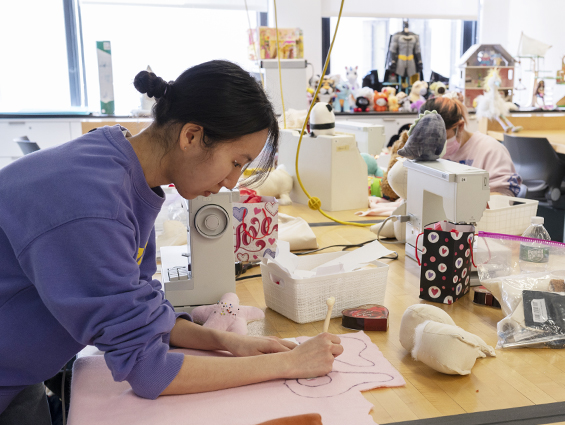Exploring how to design a toy that fascinates a kid and excites his imagination? This comprehensive guide will help you explore every step to bring your toy idea to life and ensure its successful journey.
Manufacturing a toy that captures the imagination of kids is quite satisfactory. Not only can your toy be a big hit if you evaluate carefully the design, development process and manufacturing cycle but also you can reap monetary rewards if your toy is a commercial success.
The Toy Design Process in 8 Steps
If you are new to the design world but have a great concept, think about working with an expert designer who can bring magic into your vision.
1. Prepare Toy Design Sketches
The toy design process typically starts with preparing sketches and blueprints, providing you with a solid foundation for creating the toy. The specific design idea is ready to present to the team after sketching and providing a visualization to your idea.
For sketching you need to observe how children interact with the environment and for this you can attend informal focus group gatherings organized by educational institutes to design a sketch .

Blueprint delves into the toy’s dimension, material and construction. Thus help you to provide exact specifications for later stages in the toy design process.
2. Create the Toy Prototype
Creating a prototype id thes second step that involves 3D modeling to show what it looks before sending it to the manufacturing department. Several methods are used for prototyping by a toy design company such as traditional clay sculpting or more efficient options such as CAD software or 3D printing technology.
Key lament includes making sure prototypes fulfill the safety regulations, product specifications and cost factors that might be involved in producing new toys.
3. Create Packaging Mockups
After prototyping, conceptualizing is the next step. This is usually a collaborative process between the designer and creative director. During this stage, packaging ideas are discussed to make the standout on the market shelves while providing key information about its features to attract the potential buyers.
Packaging designers can add fun elements like illustrations and eye-catching color to appeal to the kids.
4. Create Test Toys
Toy creators put their heart and soul into developing exciting new designs, but the fourth step of production can be super exciting. This is when the test version is created for the new toy.
The first version contains all features of the consumer product while the second version might have some unique features as you experiment with required adjustments before deciding on the final version.

This step is crucial to verify that the toy meets all specifications while getting valuable feedback on how people do various designs of the toy.
5. Receive Final Toy samples
The fifth step includes receiving the final samples of your toy. After months of efforts and perfecting the new toy has finally completed in the hands of its creator and ready to be presented in the market by the toy design company.
At this each piece is thoroughly inspected to encompass every detail from the accuracy of parts to the manufacturing quality.
This stage ensures that each new toy works as expected and lives up to your expectations, before you launch it for mass production. Whether it’s an action figure or a plush toy, there’s no better feeling than holding your finalized creation for the first time.
6. Design Final Packaging
Once the toy is finalized its time to decide for the packaging. It is the final developmental process where a packaging designer might work with 3D models and graphic designs to create samples for your final packaging to look at while ensuring it adheres to safety protocols.
The graphic design is being refined until it receives a go ahead from all stakeholders about its appearance and agrees that it is suitable for markt presentation.
During the process graphic designers must develop full campaigns around the toy’s release which includes banner creation and other promotional designs for both physical stores and online selling platforms.
All this arrives in a neat package ready to be presented to the customers before being finally shipped to the warehouse.
7. Maintain quality control
During the final steps and even after release of the product, the product management team makes sure to maintain the quality control of ongoing toy production. This team has the most significant role and the toy user experiences and feedback depends upon maintaining the quality control. The toy testing ensures whether they are suitable for the intended user base and meet safety requirements before being distributed through the marketplaces.
Product managers collaborate with different items such as marketing engineering departments and suppliers to make sure all users’ requirements are fulfilled while meeting the budget targets.
Ultimately, managing quality control during production is a complex task but a rewarding process to guarantee your customer that high quality toys make their way to little munchkins following all safety regulations to bring smiles on their faces.
Conclusion
Designing a toy from concept to creation is an exciting, interesting and rewarding journey. From sketching the initial idea to creating prototypes, testing, and ensuring quality control, each stage plays a vital role in bringing a child’s next favorite toy to life.
By focusing on creativity, safety, and market appeal, you can transform your idea into a product that not only captivates young imaginations but also stands out in the competitive toy industry. Whether you’re an aspiring designer or working with professionals, the process is full of magic, innovation, and, ultimately, joy for the kids who will enjoy it. These toys bring smiles on the young faces making every success worthwhile..
In the end, creating a successful toy requires dedication, attention to detail, and the ability to adapt to market trends and feedback, ensuring both fun and safety.



